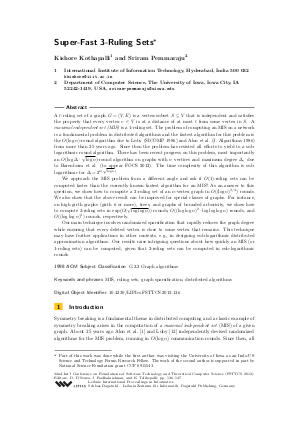Super-Fast 3-Ruling Sets
Authors Kishore Kothapalli, Sriram Pemmaraju
-
Part of:
Volume:
IARCS Annual Conference on Foundations of Software Technology and Theoretical Computer Science (FSTTCS 2012)
Part of: Series: Leibniz International Proceedings in Informatics (LIPIcs)
Part of: Conference: IARCS Annual Conference on Foundations of Software Technology and Theoretical Computer Science (FSTTCS) - License:
 Creative Commons Attribution 3.0 Unported license
Creative Commons Attribution 3.0 Unported license
- Publication Date: 2012-12-14
File

PDF
LIPIcs.FSTTCS.2012.136.pdf
- Filesize: 0.52 MB
- 12 pages
Document Identifiers
Subject Classification
Keywords
- MIS
- ruling sets
- graph sparsification
- distributed algorithms
Metrics
- Access Statistics
-
Total Accesses (updated on a weekly basis)
0Document
0Metadata
Abstract
A t-ruling set of a graph G = (V, E) is a vertex-subset S that is independent and satisfies the property that every vertex v in V is at a distance of at most t from some vertex in S. A maximal independent set (MIS) is a 1-ruling set. The problem of computing an MIS on a network is a fundamental problem in distributed algorithms and the fastest algorithm for this problem is the O(log n)-round algorithm due to Luby (SICOMP 1986) and Alon et al. (J. Algorithms 1986) from more than 25 years ago. Since then the problem has resisted all efforts to yield to a sub-logarithmic round algorithm. There has been recent progress on this problem, most importantly an O(log Delta . sqrt(log n))-round algorithm on graphs with n vertices and maximum degree Delta, due to Barenboim et al. (to appear FOCS 2012). The time complexity of this algorithm is sub-logarithmic for Delta =2^{o(sqrt{log n})}.
We approach the MIS problem from a different angle and ask if O(1)-ruling sets can be computed faster than the currently known fastest algorithm for an MIS? As an answer to this question, we show how to compute a 2-ruling set of an n-vertex graph in O((log n)^{3/4}) rounds. We also show that the above result can be improved for special classes of graphs. For instance, on high girth graphs (girth 6 or more), trees, and graphs of bounded arboricity, we show how to compute 3-ruling sets in exp(O({sqrt{loglog n}})) rounds, O((log log n)^2 .logloglog n) rounds, and O((loglog n)^3) rounds, respectively.
Our main technique involves randomized sparsification that rapidly reduces the graph degree while ensuring that every deleted vertex is close to some vertex that remains. This technique may have further applications in other contexts, e.g., in designing sub-logarithmic distributed approximation algorithms. Our results raise intriguing questions about how quickly an MIS (or 1-ruling sets) can be computed, given that 2-ruling sets can be computed in sub-logarithmic rounds.
Cite As Get BibTex
Kishore Kothapalli and Sriram Pemmaraju. Super-Fast 3-Ruling Sets. In IARCS Annual Conference on Foundations of Software Technology and Theoretical Computer Science (FSTTCS 2012). Leibniz International Proceedings in Informatics (LIPIcs), Volume 18, pp. 136-147, Schloss Dagstuhl – Leibniz-Zentrum für Informatik (2012)
https://doi.org/10.4230/LIPIcs.FSTTCS.2012.136
BibTex
@InProceedings{kothapalli_et_al:LIPIcs.FSTTCS.2012.136,
author = {Kothapalli, Kishore and Pemmaraju, Sriram},
title = {{Super-Fast 3-Ruling Sets}},
booktitle = {IARCS Annual Conference on Foundations of Software Technology and Theoretical Computer Science (FSTTCS 2012)},
pages = {136--147},
series = {Leibniz International Proceedings in Informatics (LIPIcs)},
ISBN = {978-3-939897-47-7},
ISSN = {1868-8969},
year = {2012},
volume = {18},
editor = {D'Souza, Deepak and Radhakrishnan, Jaikumar and Telikepalli, Kavitha},
publisher = {Schloss Dagstuhl -- Leibniz-Zentrum f{\"u}r Informatik},
address = {Dagstuhl, Germany},
URL = {https://drops.dagstuhl.de/entities/document/10.4230/LIPIcs.FSTTCS.2012.136},
URN = {urn:nbn:de:0030-drops-38549},
doi = {10.4230/LIPIcs.FSTTCS.2012.136},
annote = {Keywords: MIS, ruling sets, graph sparsification, distributed algorithms}
}
